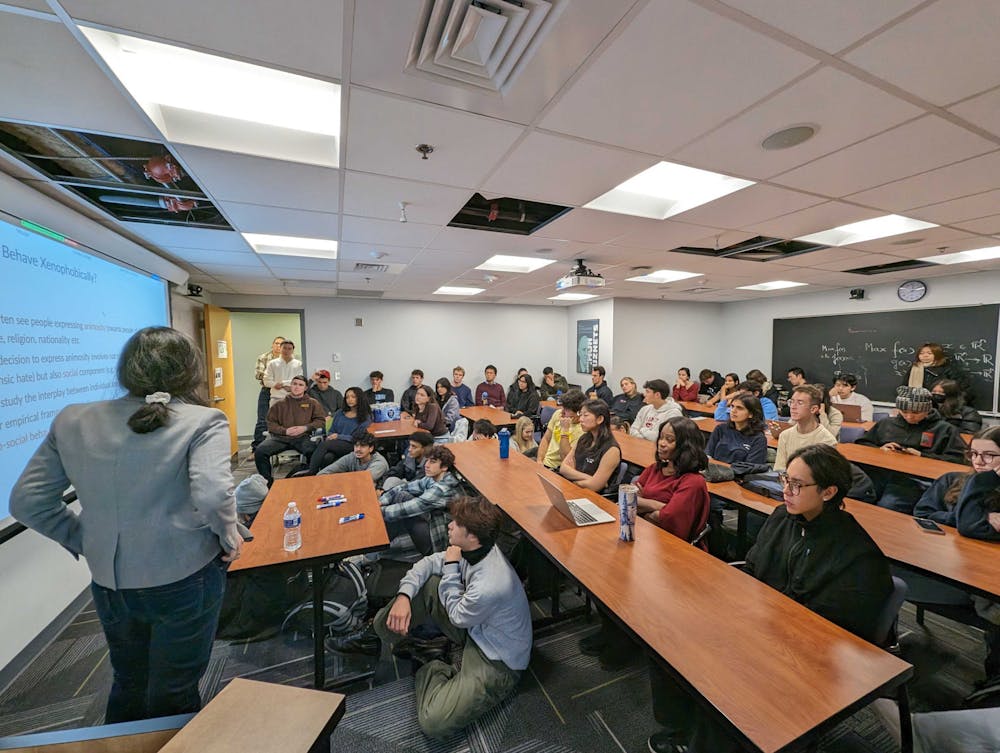The Economic Policy Issues Colloquium (E.P.I.C.) held an event titled “Structural Analysis of Xenophobia” on Friday, Dec. 1. To an audience of undergraduate and graduate students, Assistant Professor at the Department of Economics Yujung Hwang presented her study on the development of Sinophobia in America over the pandemic and its lasting effects.
In an email to The News-Letter, Dr. Hellen Seshie-Nasser, co-faculty advisor of E.P.I.C., explained the purpose of the talk.
“In the wake of the COVID-19 pandemic and the related anti-China sentiments, policymakers and researchers alike aim to find ways to reduce racism and xenophobia,” she wrote. “The talk aims to discuss the observed sources of xenophobia and effective policy tools to reduce its incidence.”
Saisha Khanna, a junior majoring in Economics and Public Health, spoke on her motivation to attend the event in an interview with The News-Letter.
“This was a new topic I had not heard before from economics. I was interested to learn about this different perspective on applying economics and its integration with other fields,” she said.
In fact, Seshie-Nasser pointed out that such application and integration of Hwang’s research methods was key reason behind organizing this event.
“Not only would the discussion enlighten students on the topic as active members of society, but it gives them tools as future policymakers,” she wrote.
The conversation began with the definition of xenophobia, which Hwang explained as hate against an identity related to race, religion and nationality. She is particularly interested in examining people’s motivation to express xenophobic sentiments in public.
Hwang identified two types of motivations. The most direct motivation is when an individual has apathy toward an identity from which they derive pleasure in openly expressing hate. Alternatively, social behavior that contributes to modifying the expression of that hate is the second motivation.
“People have these perceptions about social norms and care about reputational consequences. Depending on how people think about such consequences, there is more variability in xenophobic expression,” Hwang stated.
In her research, Hwang and her team modeled the social component of xenophobia and collected survey data to assess the most effective policy intervention. For example, a policy could take the form of exposing people to communities of diverse identities and backgrounds or releasing official statements against racism.
During the presentation, Hwang shared how she employed her model to study anti-Chinese sentiments, or Sinophobia, in the U.S. during the pandemic. The theoretical expression she used accounts for various contributions to Sinophobic expression in public, including terms such as “racial animus” and “perceived social acceptance.”
The xenophobic behavior of an individual is analyzed quantitatively and expressed through economic equations. Hwang and her team then applied these expressions to a large-scale survey study to examine Sinophobic trends in the U.S. over the pandemic.
In an interview with The News-Letter, Riley Gist, a junior majoring in Public Health and Economics, shared that she was intrigued by the method of analysis Hwang presented.
“I found it interesting to see the use of economic models to quantify human emotions and biases,” she said.
The team took care to design their survey to acquire information as accurately as possible. First, the survey was distributed online by a survey firm to ensure the anonymity of the research team and prevent biases. In May 2021, Hwang and her team sampled over 2,000 individuals of non-Asian populations in the U.S.
“Sometimes the noise ratio is very high for online surveys. We included several attention checks throughout the survey and excluded the results from participants who failed these checks,” Hwang said. “We had to make sure that people provided an honest response, because racism and xenophobia are very sensitive topics, and people may be afraid of reputational consequences.”
The survey questions were generated by social psychologists and measured attitudes against Chinese immigrants. Participants were asked about their perspectives and what they believe to be the view of a typical American citizen.
To validate the authenticity of the survey responses, Hwang compared the Twitter profiles of participants with the survey data and found consistency in expressed sentiments.
The correlation between racial animus and xenophobic expression matched Hwang’s theoretical prediction. In the context of the pandemic, data revealed that COVID-19 resulted in increased racial animus toward Chinese immigrants.
“We predict that the long-term effect of COVID infections on xenophobic behaviors will be mild, because people will adjust their thinking about reputational gain. With the assumption of a polarized individual attitude, people with moderate racial animus don’t want to be categorized with the extreme,” Hwang stated.
In an interview with The News-Letter, freshman Hanfei Hu, majoring in Economics, reflected on what he learned from the event.
“There was a lot of talk about racism towards Asians during the pandemic, and it was interesting to see how economics can offer insights on the impact of such a topic,” he said.





